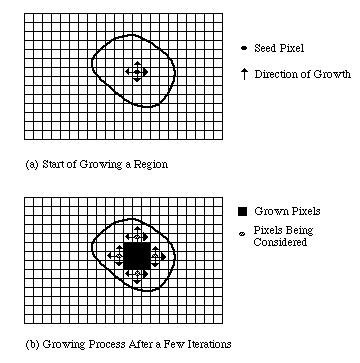


Next: Statistical Region Description
Up: Segmentation
Previous: Region Splitting
Region growing approach is the opposite of the split and merge
approach:
- An initial set of small areas are iteratively merged
according to similarity constraints.
- Start by choosing an arbitrary
seed pixel and compare it with neighbouring
pixels (see Fig 37).
- Region is
grown from the seed pixel by adding in neighbouring pixels that are
similar, increasing the size of the region.
- When the growth of one
region stops we simply choose another seed pixel which does not yet
belong to any region and start again.
- This whole process is continued
until all pixels belong to some region.
- A bottom up method.
Region growing methods often give very good segmentations that
correspond well to the observed edges.

Fig. 37 Example of region growing
However starting with a particular seed pixel and letting this region
grow completely before trying other seeds biases the segmentation in
favour of the regions which are segmented first.
This can have severalundesirable effects:
- Current region dominates the
growth process -- ambiguities around edges of adjacent regions may
not be resolved correctly.
- Different choices of seeds may give different segmentation
results.
- Problems can occur if the (arbitrarily chosen) seed point lies
on an edge.
To counter the above problems, simultaneous region growing
techniques have been
developed.
- Similarities of neighbouring regions are taken into
account in the growing process.
- No single region is allowed to
completely dominate the proceedings.
- A number of regions
are allowed to grow at the same time.
- similar regions will
gradually coalesce into expanding regions.
- Control of these methods may be quite
complicated but efficient methods have been
developed.
- Easy and efficient to implement on parallel computers.



Next: Statistical Region Description
Up: Segmentation
Previous: Region Splitting
 David Marshall 1994-1997
David Marshall 1994-1997
